We wanted to create a space that blends fun, inclusivity, challenge, and meaning. Throughout we also considered sustainability as a criterion for decision making. This wasn’t just material and resource decisions. We also integrated nature into design, play and learning. By immersing visitors in stories of local environment we can foster and promote deeper connections to environment, culture, and sustainable living.
We carefully selected materials, repurposed old playground equipment, and partnered with eco-friendly contractors and suppliers. For instance, we recycled the former playground rubber surfacing, saving costs while diverting waste from landfills. We reused multiple play items and furniture from the previous playground.
Over 95% of play equipment was crafted in New Zealand, reducing carbon emissions associated with transportation. We chose materials like New Zealand pine from sustainably managed forests and UV-resistant plastics that are fully recyclable. Additionally, we repurposed old furniture and collaborated with local manufacturers to create new pieces. Timber from the port's old wharf was repurposed into boat-shaped furniture, supporting sustainability and local heritage.
Environmental themes are woven into the playground design, educating visitors about local geology, flora, fauna, and culture. We worked collectively with mana whenua, museum and school educators, to incorporate educational elements and advocate for environmental awareness. For example, a large-scale tuna/eel links to creation, migration and mahika kai stories.
We planted many new tree’s and shrubs in the playground providing future shade, linking to stories (native and mahika kai species), providing rain gardens, and integrating nature, play and development.
Financial sustainability was prioritized through durable material choices that increase design life and therefore reduce replacement and removal wastage. For example we opted for concrete over asphalt for longevity and carefully managed drainage to prevent water pollution. Additionally, we used ACM aluminium signage with anti-graffiti coatings for durability and recyclability.
Our space is at its core inclusive, fun and meaningful to a diverse range of the community. It is free, always available, and enables long-stays and gathering. These elements lead to a sustainable social benefit to the community.
“The creation of a vibrant and inclusive playground aligns with this Government’s objectives of stronger communities and actively promotes the wellbeing of our region.” James Meager MP for Rangitata.
Our project reflects a holistic approach to sustainability, addressing environmental, financial, and social aspects. We aim to inspire others to prioritise sustainability in their projects and to learn about our local environment while engaging with our space.
Our commitment goes beyond just creating this playground; we strived to build a sustainable and environmentally friendly space to inspire and connect communities. Our approach to the new Caroline Bay Playground demonstrates our dedication to sustainability.
We took a holistic sustainability approach to utilize environmentally friendly materials, methods to optimize our project's environmental footprint from production to installation. Our playgrounds themes help our locals and visitors connect with the world around us to inspire them to be better guardians and caretakers." - Roselyn Fauth CPlay Volunteer
From the outset, our mission was clear: to create a space that not only provided fun, inclusion, challenge and meaning, but also honored our commitment to sustainability and environmental stewardship.
One of the most fulfilling aspects of this project was witnessing the integration of nature elements into the playground design. By immersing visitors in the interesting geology, flora, and fauna, we aimed to foster a deeper connection with the environment. It was inspiring to see how these thematic elements not only provided entertainment but also served as educational tools, helping people learn about the importance of sustainability and environmental conservation.
Throughout the project, sustainability was at the forefront of every decision. From the selection of materials to the repurposing of old playground equipment, every effort was made to make choices and find solutions to minimize our environmental footprint. We achieved this by partnering with contractors and suppliers who shared our commitment to eco-friendly practices.
"One particularly gratifying initiative was the recycling of old playground rubber. Watching the old rubber tiles being ground into granules and reused in the new playground safety surfacing was a testament to our dedication to sustainability. Not only did this initiative prevent waste from ending up in landfills, but it also saved on costs, demonstrating that environmentally friendly practices can also be budget-friendly." - Roselyn Fauth CPlay Volunteer
"It was also been wonderful to see the themes come together in the play space so people can have a deeper understanding of where they live and who they are, to be better caretakers and guardians of our people and place. We are seeing a curious mindset evolve, people engaging in education classes at the playground and visiting Timaru District Council facilities like the Museum, Gallery and Library to learn more." - Roselyn Fauth CPlay Volunteer
As volunteers and representative of the local community, seeing the impact of our efforts firsthand was incredibly rewarding. Knowing that our playground would provide a safe and fun space for future generations, while also promoting environmental awareness, fills us with pride. We hope that our project will inspire others to prioritize sustainability in their own endeavors, creating a brighter and more eco-conscious future for us all.
Reasons why sustainability was important to CPlay:
- Environmental Impact: Reduce pollution and carbon emissions.
- Build to last: reducing maintenance, saving money and reducing waste.
- Health and Safety: Use non-toxic materials for child safety.
- Resource Conservation: Reduce waste and repurpose materials.
- Energy Efficiency: Lower operational costs with efficient features.
- Water Management: Manage storm water and reduce runoff.
Our goals:
- Sustainable material selection
- Repurposing for sustainability
- Themed with nature and the stories around us
- Fostering environmental awareness
Chose our contractors, suppliers and materials carefully
- The site had to be scraped to provide a strong foundation. River run from Pareora River, (approx 30 minutes up the road from Caroline Bay) was trucked in and compacted. As well as improving the sites stability, we could also improve the drainage on site, as the playground site is the lowest point at the bay and can flood in rain events. The sand that was carted away will be prepared by our earth moving contractor to use on future civil work.
- Special covers were installed over storm water drains to ensure only water entered the drains that connects to the sea. The surrounding area was regularly cleaned too.
- Horse hair was used instead of synthetic material to increase the playground mounds durability,
- The earth moving contractor planted trees to help off set their carbon.
- We chose concrete over asphalt because it would last much longer and reduce waste and maintenance over the playgrounds life.
- Over 95% of the equipment was locally crafted in New Zealand, reflecting a commitment to domestic production. Likewise, all the playground equipment were expertly fabricated with a focus on durable and low-maintenance design, with readily available spare parts, all manufactured in NZ.
- Playground rope from Germany was carefully chosen, for its durability and sourcing of materials from sustainably sourced, recycled, and recyclable materials. The rope went through rigorous testing against competitors, ensuring top-notch quality. Playground Centre conducted independent tests and reports to compare the performance of this specialized rope against their various competitors, confirming its exceptional wear resistance and guaranteeing the use of the highest quality materials.
- The Shipwreck and Lighthouse slide tower were constructed with New Zealand pine timber, sourced from sustainably managed forests, reducing environmental impact. Choosing locally sourced pine over imported hardwood reduced freight content and supported sustainable forestry practices. Approximately, 900 lineal metres of pine timber were thoughtfully incorporated into the Shipwreck and Lighthouse tower designs.
- The timber of the lighthouse and sections of the shipwreck were triple coated in Resene Eco Paint by Resene accredited Eco Decorators to protect from Caroline Bay's salt air and increase the life of the product and reduce toxic chemicals in paint surfaces, promoting a healthier environment for children and minimizing pollution risks.
- The steel, and aluminium substructures were chosen for their strength, durability, and recyclability. They were triple coated to protect the surfaces from the Caroline Bay salt air. The aluminium used in majority of the Caroline Bay playground equipment were sourced from New Zealand smelters, ensuring 100% recyclability. Offcuts and scrap were recycled, minimizing waste, and maximizing resource efficiency.
- UV-resistant plastics for superior fade resistance and are fully recyclable at the end of their lifecycle and sources and manufactured in New Zealand. The UV stabilizers, undergo rigorous rigorous testing by BRANZ for superior fade resistance compared to imported alternatives. At the end of their lifecycle, these plastics are fully recyclable.
- We chose a mix of metal and timber to take advantage of sourcing, manufacturing process, durability, and end-of-life considerations. Both materials can be sustainable options when sourced responsibly and managed throughout their lifecycle.
- The small rubbish bins were replaced with larger rubbish and recycling bins to encourage people to keep the playground litter-free, reducing rubbish and pollution.
- We have incorporated gardens and mulch including native plants to help restore the soil and ecology of the area. The plants so far have come from local nursery Plantorama, and Matai Nurseries in Waimate who specialize in New Zealand native plants for landscaping re-vegetation and amenity purposes. The plants were chosen by Timaru District Council parks team to suit the sea environment, aesthesis and practical requirements of the playground.
- We incorporated natural play elements like rocks and logs to help foster a deeper connection with the natural world and the ocean only 60m away from the playground.
Repurposed where we could
- In 2023, the 29 year old rubber from the old playground was pulled up, taken to Creo/Numats Oamaru recycling plant and broken down into crumbs so it could be re-used in the new playgrounds black safety surfacing's. CPlay was proud to be the first playground in the country to be able to do this, skip the landfill and re-use. Rubber granules in the safety surfaces, are non-toxic ensuring the playground remains safe for children while minimizing environmental impact.
- We re-sited the rope pyramid and renovated the 1960s nostalgic yellow horse, and kept the metal slide in the embankment.
- Old furniture was refurbished and re-sited.
- We worked with local manufactures to design and create new furniture, such as benches and super large accessible table.
- Other equipment was removed so it could be re-used at the discretion of the Timaru District Council.
- Timber from the Ports old wharf was gifted and shaped for boat shaped furniture in the playground.
Shared stories and information incorporating environmental themes
The playground design and themes were inspired by Caroline Bay and the Timaru District. We have special environment here that we can be better guardians and caretakers of, which can be inspired through awareness and deeper connection.
- Our playground themes start with 50 million year fossils from the evolution of Zealandia. (icons in the surfacing and information signs)
- South Islands most recent volcanic activity at Wapouri (Mt Horrible) 2.5 million years ago that offered habitat to marine life. (themed obsitical course to the floor is lava with symbols of fault line and lava source). We also included basalt from a rock quarry on Fraser Road in Timaru.
- The layers of loess (glacial dust) at our cliffs, which are some of the most extensive and best examples of loess deposits in the world. A scientific paper produced in the 1890s is still referred to by scientists today to better understand the past and future changing climate. These cliffs are at the bay and playground. (Lines in the lighthouse mound symbolic of the cliffs layers). We included large rocks are from the Mackenzie Basin in the Tekapo Area.
- Creation stories and mahika kai from local Maori. (A representative from Arowhenua joined our committee to provide information, inspiration, idea and help make decisions.
- Inclusion of lost species like the moa, introduction of pests like rats and mice to explain the impact on our animals in the area.
Advocates for the environment by what we did and making the space meaningful
- We talked to our community at public events to find out what was important to them.
- A representative of mana whenua joined our committee to offer view, information, ideas and support.
- We worked along side the South Canterbury Museum, Aigantighe Art Gallery, Timaru District Libraries, and Te Ana Rock Art Centre and Environment Canterbury to understand the environmental education they provide and incorporate ideas and themes into the playground.
- We met with Venture Timaru to understand what Tourists wanted to experience and learn while at the playground.
- We met with educators to learn about the New Zealand Curriculum to understand the education requirements.
- A volunteer did the National Geographic Explorer Mindset course to inspire learnings into the playground project.
- We produced resources to help educators share information and to use the play space to deliver it.
- We guest spoke to clubs, work places, schools and and held free guided tours with the community around the playground.
- We fundraised at Eco Car Washes and created playground fun for Sea Week events.
- We commissioned and included art from children to professional artists to share ideas and themes on the world around us.
- We developed information signage to share knowledge relevant to the playground and area.
- Developed a website with all the raw sources and a summarized version, and ran social media posts and live video to share the stories and knowledge.
Lessons we learned
- Collaboration is key: Actively engaging and collaborating with stakeholders from the outset fosters meaningful partnerships and enhances project outcomes.
- Close collaboration with contractors and suppliers: Working closely with contractors and suppliers allows for successful addressing of sustainability challenges and implementation of innovative solutions.
- Ensure positive long-term environmental impact: Efforts should be directed towards ensuring a positive and tangible long-term environmental impact, promoting stewardship and sustainability.
- Holistic approach to sustainability: Integrating sustainability into every aspect of the project ensures comprehensive environmental, social, and economic considerations are addressed.
- Scalability and replicability: Lessons and achievements should be easily scalable and replicable, providing a blueprint for sustainable practices in similar projects.

CPlay volunteers mark the start of the project by helping to remove the rubber that was laid by Numat 29 years earlier. It was ground up and re-used in the new playground.

Medinella Fauth (8) with the rubber crumbs created from the old play surfacing that was used in the new playgrounds black safety surface. - Photo Roselyn Fauth
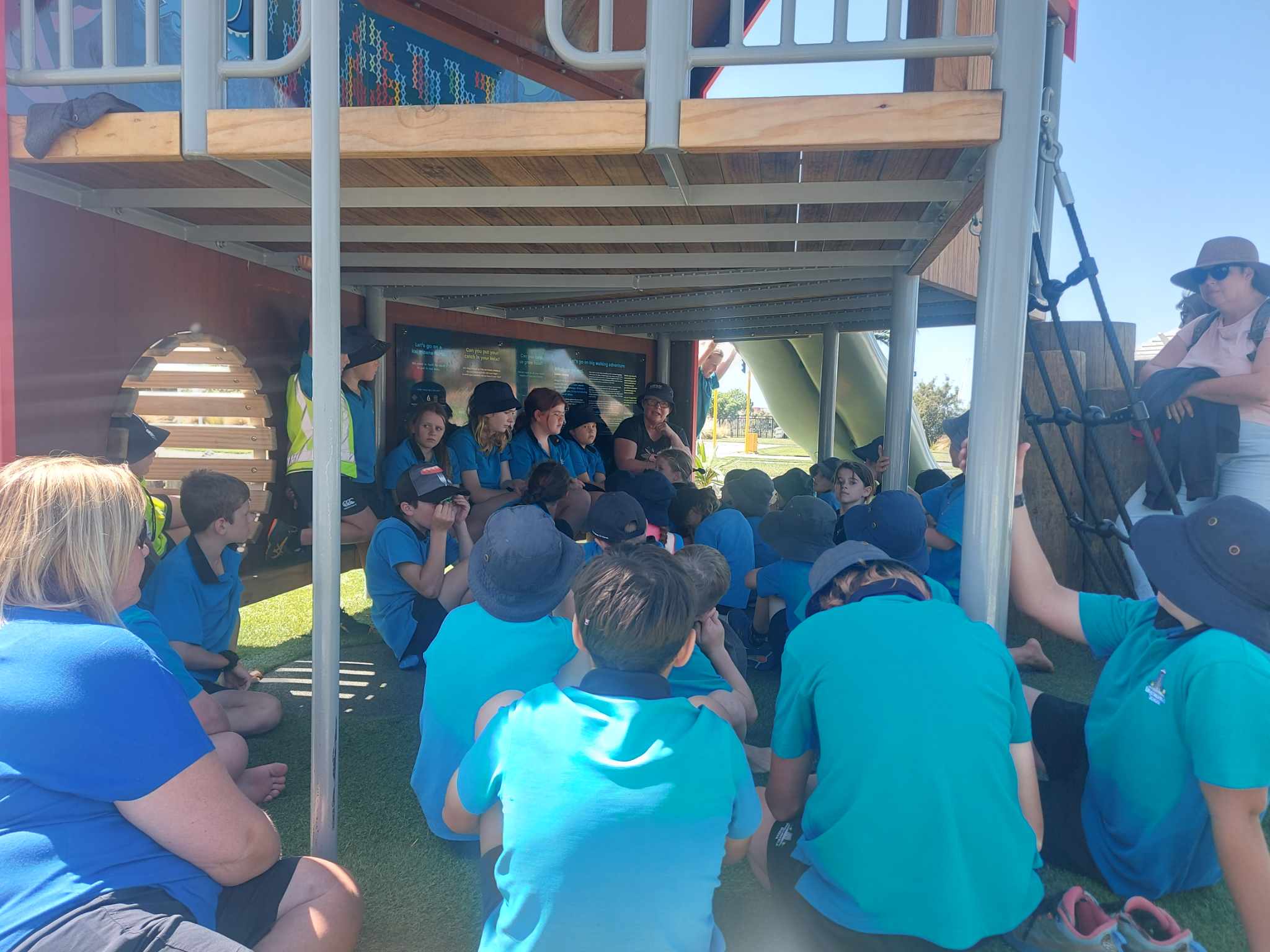
South Canterbury Museum educator Keely Kroening gives the first educational school visit in the new playground 21 February 2024. The students were taught about mahika kai and tuna (eel) in the local area to raise awareness of the world around them and explain how we can care for the environment. - Photo Roselyn Fauth

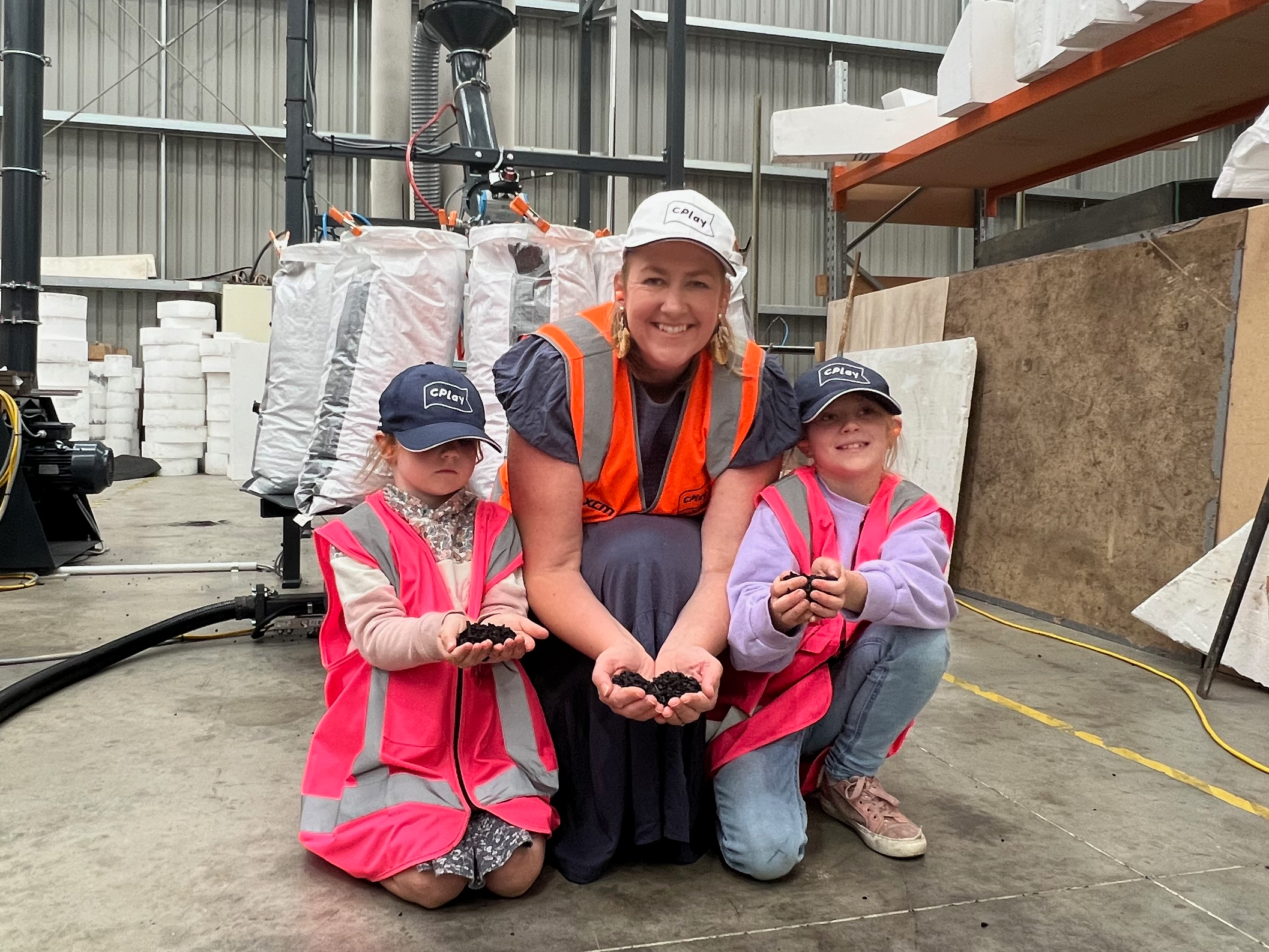
ABOVE: CPlay volunteer Roselyn Fauth with daughters Medinella 8 and Annabelle 4 visited the new recycling plant to see the old rubber go through the recycling process.
The Caroline Bay Playground construction got underway in March 2023, and saw the removal of equipment and surfacing to clear the site for the earthworks to commence in April.
The old rubber playground tiles, which had been in use for many years at Caroline Bay Playground, were removed, tested and then sent an hour down the road to be recycled. Now truckloads of the old rubber surfacing can skip the tip and be recycled at the Numat/Creo recycling plant in Oamaru.
- Caroline Bay Playground construction began in March 2023, clearing the site for earthworks in April.
- Old rubber from the playground was recycled at Numat's/Creo's Oamaru recycling plant.
- Rubber was shredded and ground into granules, reused in the base of the safety surfaces.
- 400m² of the matting was removed from the Timaru playground, and about 2500m² was being put down.
- CPlay chose recycling for budget and eco-friendliness, aligning with playground's environmental focus.
- Playground's play surface investment prioritizes safety, sustainability, and accessibility.
- Numat's/Creo's Pour’n’Play® product, 100% recycled rubber, was selected for the surface.
- CPlay volunteer, Francine Spencer emphasized recycling's role in reducing waste and pollution.
- Numat recycling plant's innovative methods support sustainability.
- New playground's matting incorporates recycled material, cushioning falls, and increasing accessibility.
- CPlay volunteer Roselyn Fauth highlighted sustainability's importance for future generations.
- Timaru District Mayor Nigel Bowen praised recycling, connecting it with Timaru's recycling, and efforts to re-use.
- The $2.98 million project was funded by donations, grants and the Timaru District Council.
- Council will maintain the community-led upgrade upon completion.
- When the rubber is no longer needed, it can be removed and recycled again.
"The collaboration between NumatREC, Sustainable Fun for Everyone, and NumatAGRI is more than a playground project. It’s a model for sustainability, innovation, and community engagement. It’s a step towards a future where the surface of our playgrounds reflects a commitment to the circular economy, community, and the joy of play."
https://www.numatrec.co.nz/2023/08/turning-waste-rubber-into-sustainable-playgrounds-timaru/


Numat/Creo's marketing manager Jon Coursey, left, Francine Spencer, center, and CPlay volunteer Roselyn Fauth at Timaru's under construction CPlay showing the recycled rubber matting for the playground. - Aug 11 2023, Timaru Herald - AIMAN AMERUL MUNER/STUFF



Drone view of progress at Caroline Bay Playground in Timaru. Exciting developments as the rubber safety surface takes shape, soon to be adorned with vibrant recycled rubber and turf. This accessible and low-maintenance design, made possible by dedicated volunteers and fundraisers, promises endless fun for kids of all ages. - Photo Jack Rushton
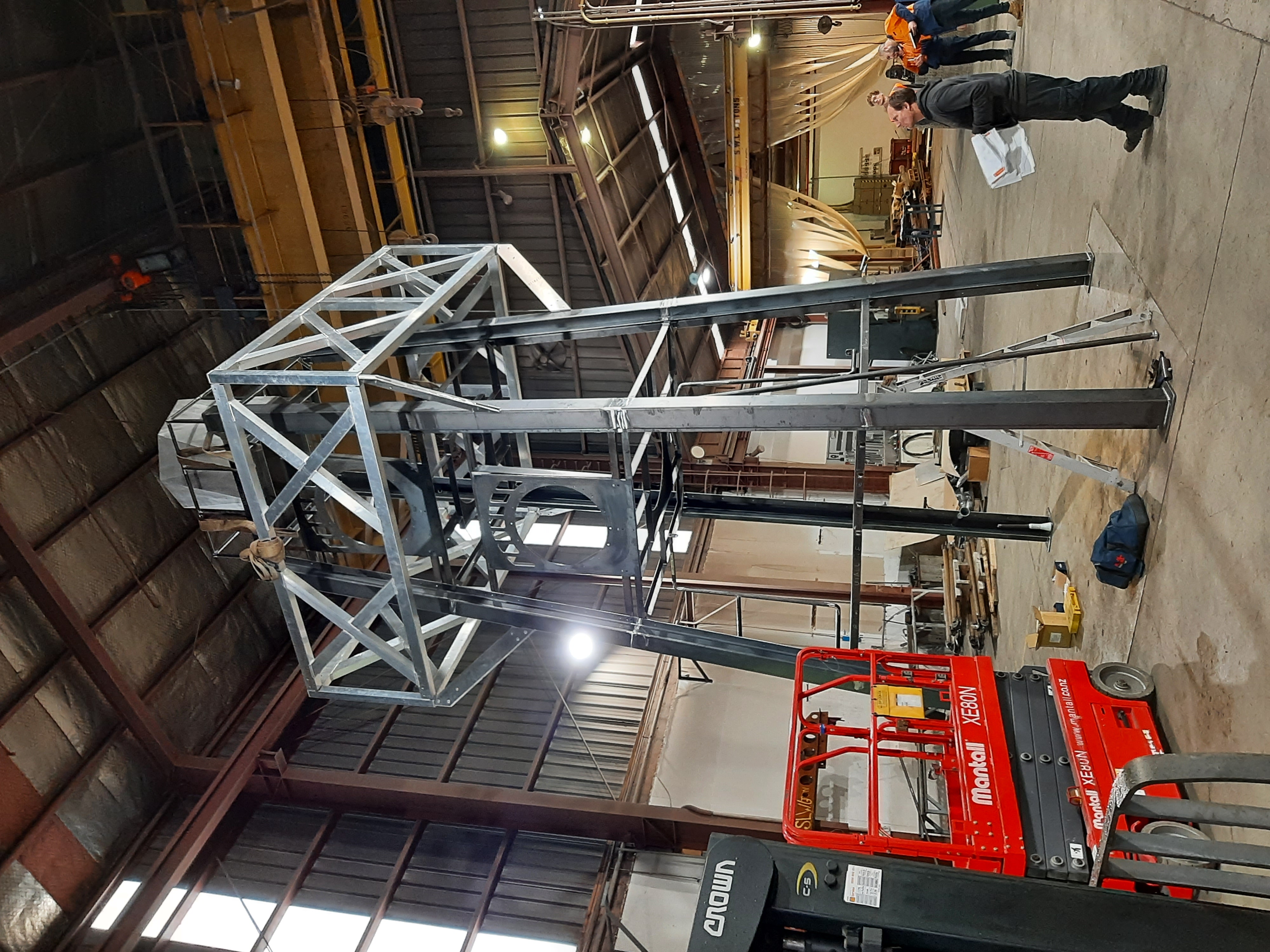
Staff at The Playground Centre in Whanganui inspect the design, manufacture and construction of the four-story lighthouse slide tower for the new Caroline Bay Playground. The frame was pre› assembled in order to check the fit and run through safety and quality checks. PHOTO: SUPPLIED


Throughout the project, we focused on creating a vibrant and enduring play space by choosing the Playground Centre's premium coating option, "HURRICANE GALV," to safeguard the playground's steel structures against corrosion and degradation. This coating, applied after hot-dip galvanizing, ensured lasting protection from rust and deterioration, crucial in a salt-laden environment like Caroline Bay. By opting for galvanized steel, which is 100% recyclable, and employing quality control measures during fabrication and assembly to make sure we were creating a sustainable legacy for our community.

The lighthouse slide tower arriving in Timaru with Caroline Bay Playground, Caroline Bay, and the Southern Alps in the distance - Photo Playground Centre

1980 Photograph of the lighthouse being relocated from The Terrace to Te Weka St. Courtesy of South Canterbury Museum CN: 2014/107.73 And the new lighthouse tower inspired by the Blackett Lighthouse being lifted into place 2023. - Photography by Roselyn Fauth

Curle Construction team bring the Playground Centre's lighthouse onto site - Photo Playground Centre
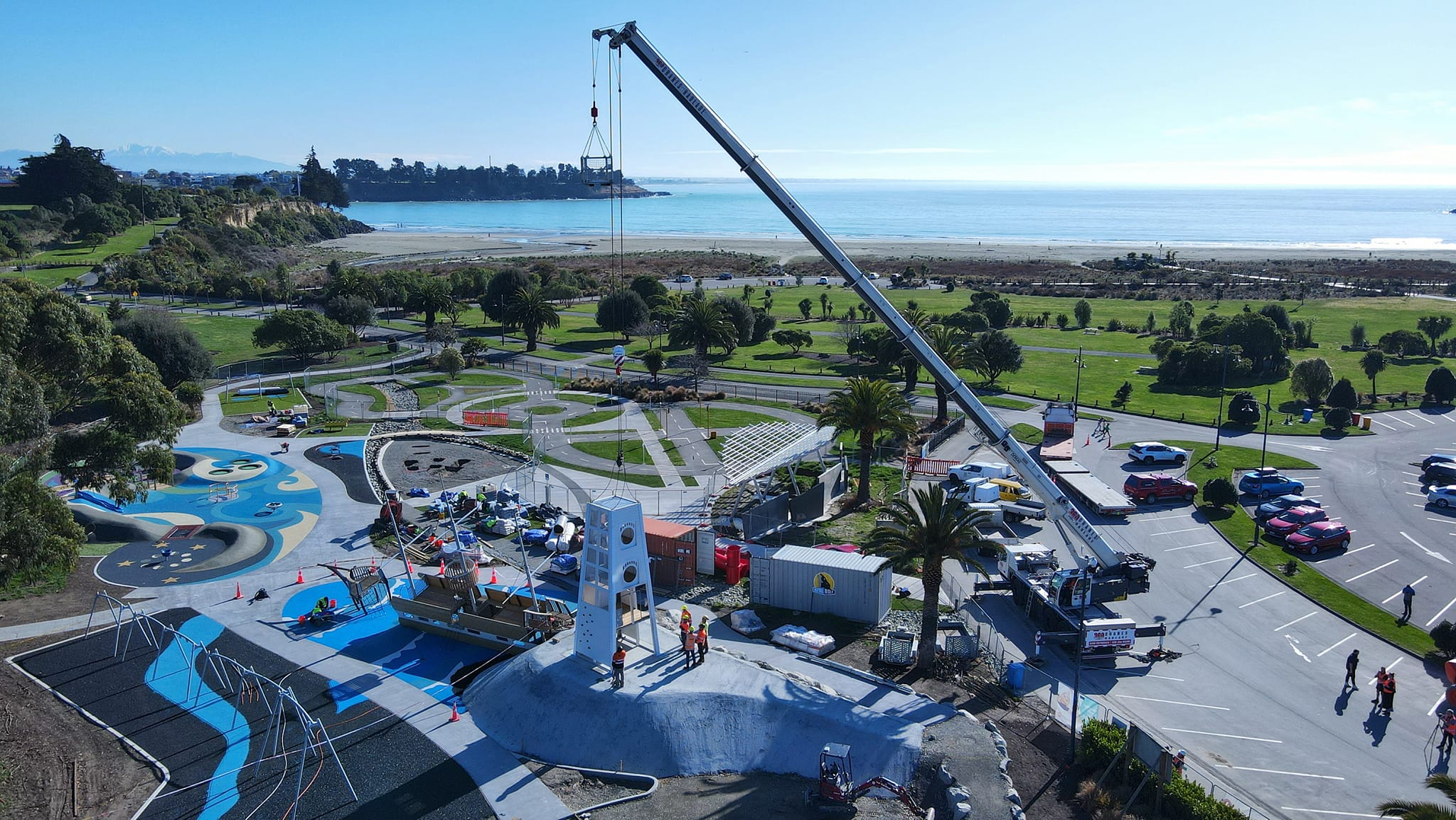
CPlay lighthouse lifted into position with the mahika kia and tuna eel themed spaces behind. - Photo South Canterbury Drone Photography

Photos shared by the community of their memories of the old horse from the early 1960s.

The iconic yellow horse re-sited, refurbished and rearing to go - some of the CPlay volunteers kids gave it a test ride. - Photo Roselyn Fauth

The rope pyramid was re-sited. This was to enable earthworks in on the site and to make way for the lighthouse mound and new swings.


The old swings, ready to be removed - 23 March 2023 - Roselyn Fauth

Some of the new swings from Playground Centre at Caroline Bay Playground - Photo Roselyn Fauth

The earthworks materials are locally sourced. The large boulders came from Takapō/Tekapo and are the rocks that glaciers ground into dust 10,000 to 6,000 years ago. The dust blew into Timaru over that time and formed layers. You can see these in the loess cliffs at the bay. The layers are studied all over the world to help people better understand climate change, and predict our future.

Used natural elements like rocks and logs to give opportunity for people to walk on un even surfaces to improve balance, strength and co-ordination. This helps soften the hard surfacing and bring nature play to the space in a easy to maintain and sustainable way.

Nod to our river beds and bringing nature play opportunity to walk around un even surfaces - Photo Roselyn Fauth

Local river run was trucked into the playground from 15 minutes up the road. This was to improve the sites drainage and foundation for the play equipment and surfacing.

Volcanic rocks, local basalt circle a nod to a hangi pit - Photo Roselyn Fauth

We were told by a teacher that they have been surprised how many of their students struggled to walk on a rocky river bed while on field trips. There are so many missed opportunities for development and experiences. CPlay incorporate Rocks and Logs into the CPlay playground to offer play on un-even surfaces to help our kids build balance, strength and confidence. These also helped to define areas of play, keep the bikes and scooters out of the under 5 year play space.

Mulching was introduced to the garden areas to improve the ecology.

The loess cliffs are world renowned, and are used to understand climate change. We incorporated the cliff layers into our play surface.

Bringing tuna eels and dolphins into the playground help bring environmental themes into the playground.

Mahika Kai themes help educate our locals and visitors about our environment and how to be great caretakers.

From Left: Craig O'Keeffe, Spongy (Jmac Joinery), Rich Geary, Steven Brooks sit with the new benches created from donated century old Timaru warf timber. Thank you to PrimePort, Rushton Architects, Milled by Spongey from JMac Joinery, brackets by Humphris Engineering and constructed and installed with the help from South Canterbury Registered Master Builders Association, BCITO, Craig O'Keeffe Building, and Bcito (provider of building and construction trade apprenticeships).

Looking over the Port of Timaru out to the first breakwater, in the foreground is the timber that has been removed from the warf. Some was donated to CPlay to construct furniture. - Photo Roselyn Fauth

Bill Steans, Parks & Recreation Manager and Wayne Loveday, Parks Horticulture Liaison Advisor helped advise on the plantings at CPlay to soften the hard surfaces with nature - Roselyn Fauth
For the planting some of our goals with the support of the Timaru District Council were to:
- Include native and local plants, for the specific environment, ecology, enjoyment and story telling.
- Prioritize water efficiency
- Minimise waste by using durable infrastructure.
- Nurture soil health and apply organic mulch, produced locally by the Timaru District Council Parks and Reserves team.
- Encourage biodiversity.
- Plan for year-round interest.
- Ensure accessibility for all, particularly in our sensory garden.
- Develop a maintenance plan and regularly evaluate sustainability efforts.
A drone photo showing the progress on the Sensory Garden to be developed - October 10 - Photo Jack Rushton


We held events for Sea Week and helped wash cars with the TDC's support to educate how to clean your car in a more eco-friendly way, we talked to people getting their car washed and posted a live video demonstration via Facebook.
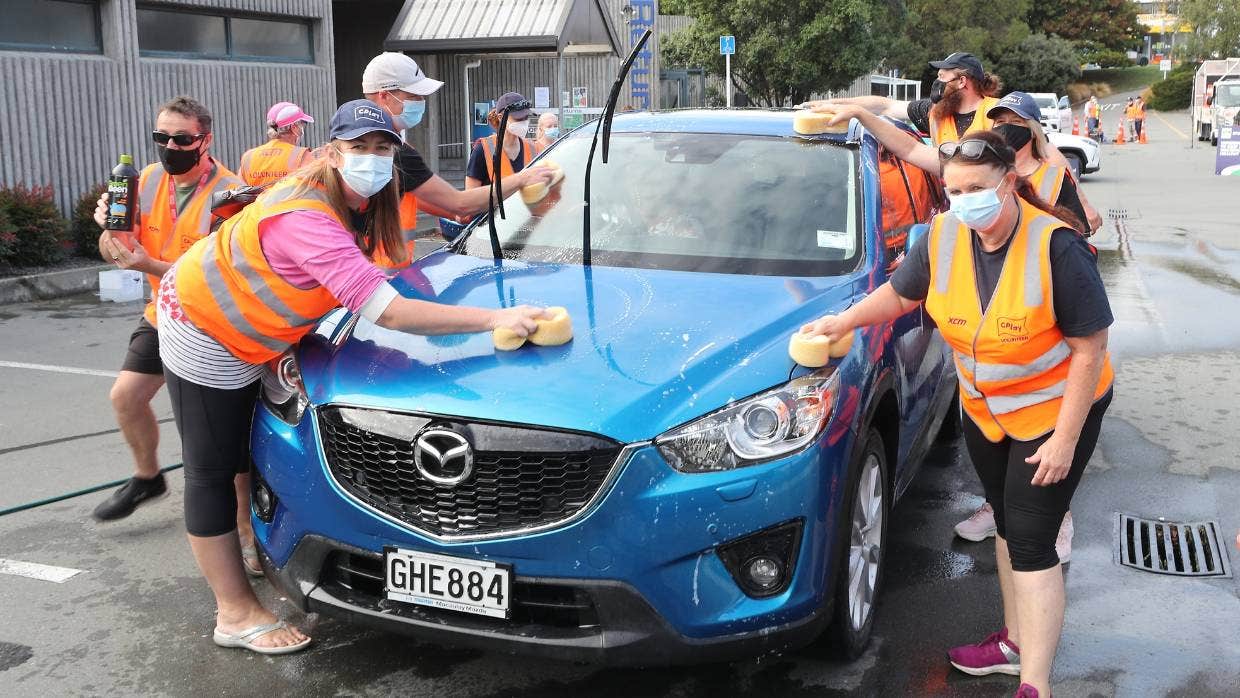
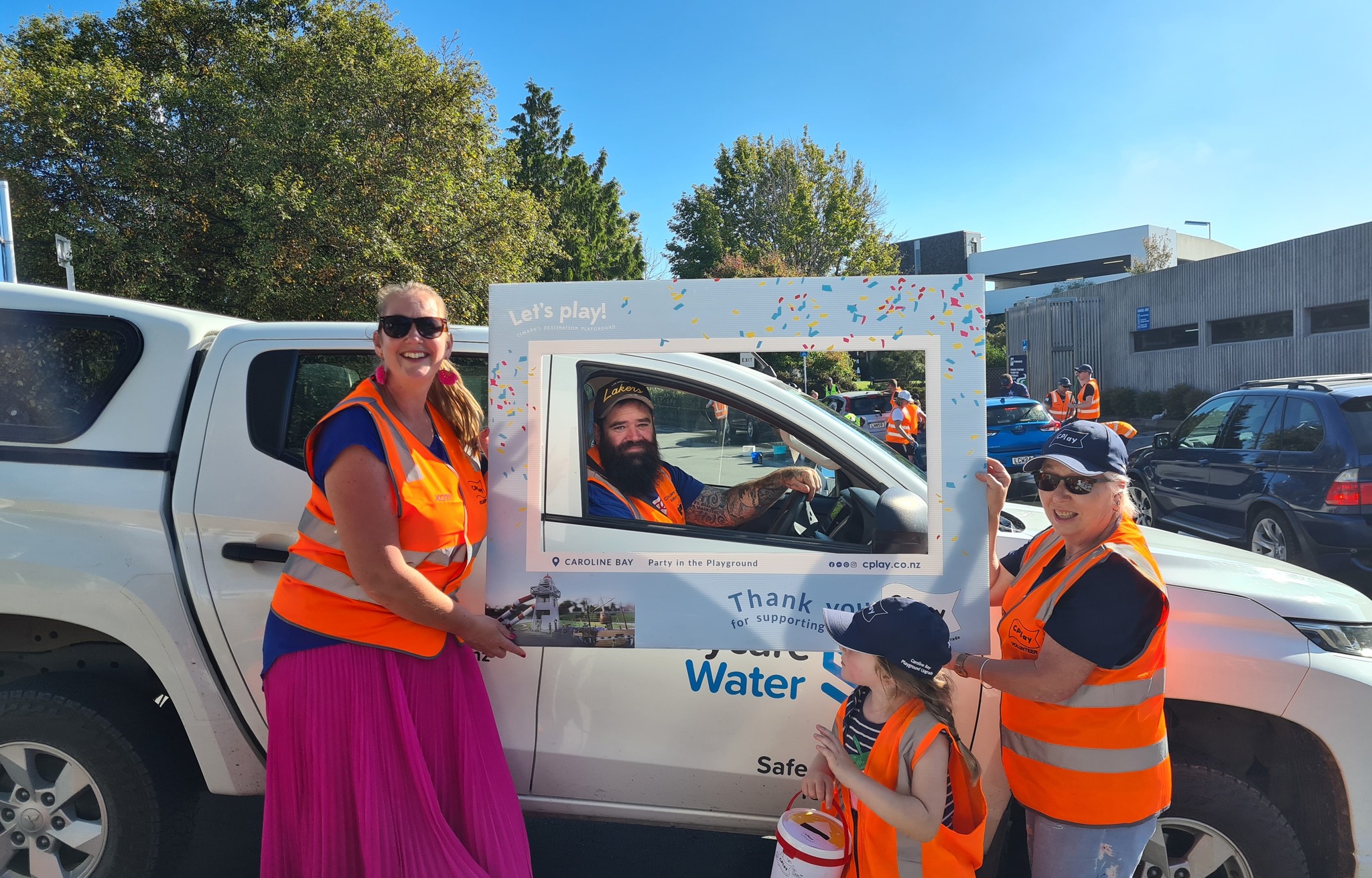
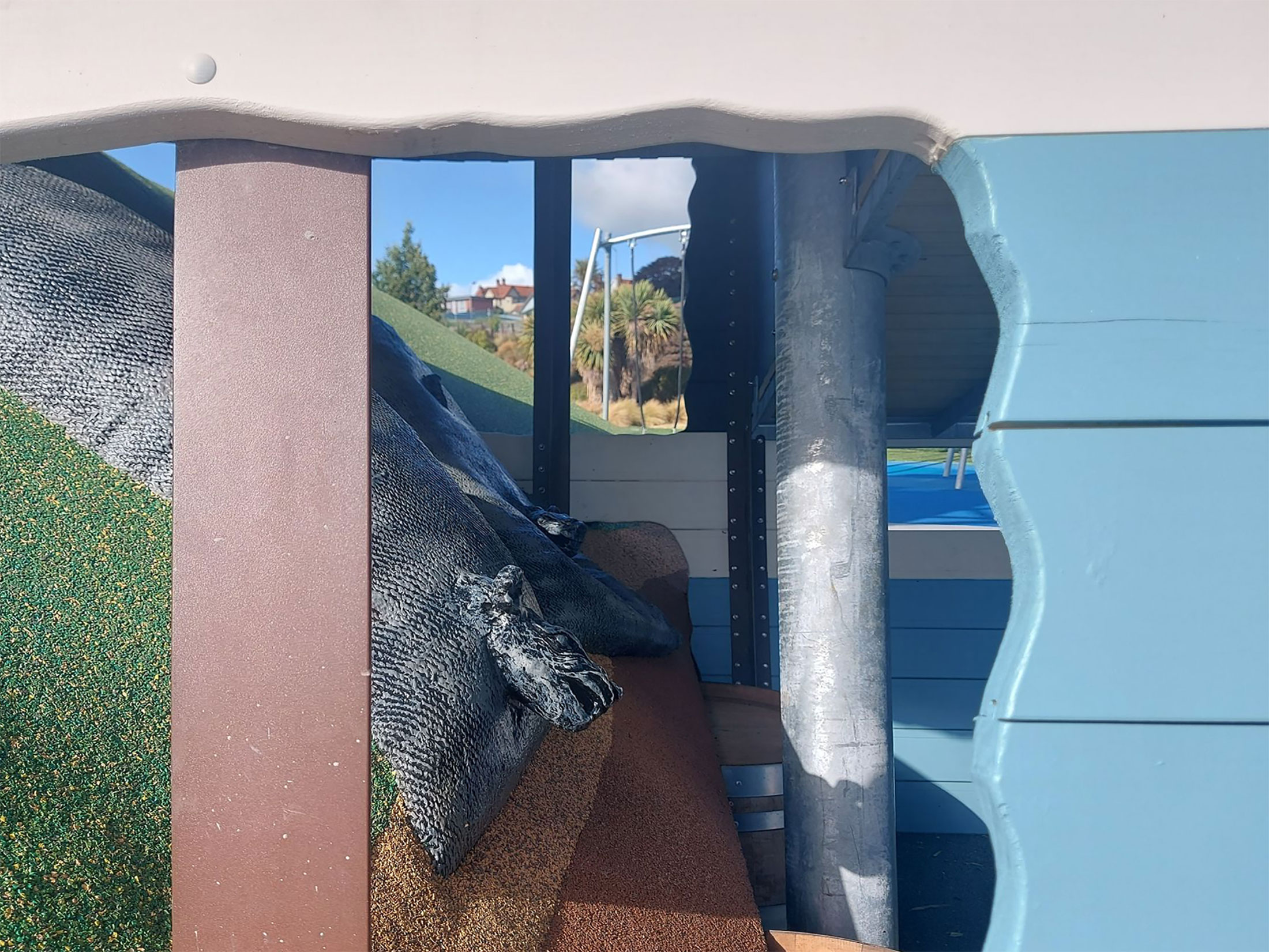
Play while learning about the the environment and impact pests made to our local flora and flora. No shipwreck would be complete without some stowaways. The CPlay team commissioned sculptor Don Patterson to create some naughty rat bags for the new playground. - Photo Roselyn Fauth

Floor is lava was inspired by the local lava that created reefs and habitats for local marine life.

ABOVE: 4 year old Annabelle Fauth with her father CPlay Volunteer Chris Fauth visited, Waitarakoa Washdyke Lagoon and Caroline Bay to learn about birds, their behavior and their footprints. Actual bird feet (Kororā (Little Blue Penguin), Pūkeko (Australasian Swamphen)) were 3D scanned and printed by volunteer Jack Rushton so they could be pressed into the concrete paths. The footprints will add a touch of natural history and educational value to the playground, as well as create an interesting and unique design element for educators to point out and use as a learning opportunity. Photo by Roselyn Fauth
"It was great to share the feet of these birds to help locals and visitors understand the history of our area and be informed about the views of mana whenua. In traditional Māori culture, birds played a significant role by providing food and feathers for adornment and cloaks. We watch how birds behave, to inspire metaphors, poetry and help predict the weather and the future." - Francine Spencer

ABOVE: 4 year old Annabelle Fauth with her mother CPlay Volunteer Roselyn Fauth visited the Museum, Waitarakoa Washdyke Lagoon and Caroline Bay to learn about birds, their behavior and their footprints. They also saw some of the steps taken to create the moulds of birds feet, to stamp into the concrete for the new playground. Photo by Roselyn Fauth

The southern cross and pointers install underway to help people learn about celestial south and navigation. Photos Roselyn Fauth

Artist Francine Spencer with taniwha that she designed for CPlay. It can be viewed as a guardian or a creature to be careful of.he Taniwha artwork adds a playful element to the 50m tandem flying fox, inspiring children and adults to pretend they are on a sea rescue mission, and to learn about Maori perspectives of caring for the world around us. The Taniwha artwork is a nod to the importance of the natural world and the spiritual connections that Māori have with it. "Taniwha are considered to be powerful guardians of the land, waterways, and natural features such as mountains, forests, and rivers," said CPlay volunteer and artist Francine Spencer. - Photo Roselyn Fauth

An education resource to help people learn about the shipwreck history and need for a Port. This information was turned into a prompt to inspire others to create their own shipwreck scenario and play it out in the playground with the flying fox and lifeboat themed equipment.






